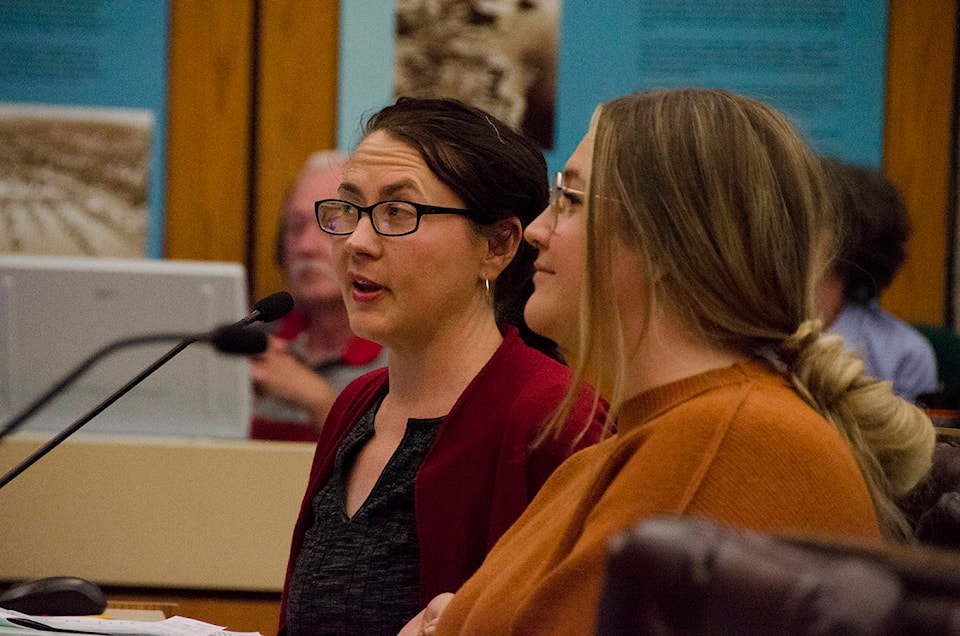The results of a recent study by the Strathcona Regional Health Network (SRHN) – in partnership with the Campbell River and District Coalition to End Homelessness (CRDCEH) – which saw “ideas walls” placed in various public spaces throughout the community, were presented to Campbell River City Council last week.
Libby King, coordinator of the SRHN, was once again before council June 24, along with Kristi Schwanicke, the new coordinator for the CRDCEH, sharing the feedback received during the study, dubbed Affordable Housing Benefits Everyone, which took place in May.
The “key themes” that they heard during the study, they told council, were affordability of housing, the need for a greater divrsity of types of housing, densification and infill to provide more housing that is closer ro amenities and services and zoning/regulation changes to allow for more housing types.
King says the study was “a great opportunity for us to hear from people about the kinds of housing they have lived in at various points in their lives, as well as what they see as being missing from the equation in terms of housing stock in Campbell River right now and how we need to move forward into the future.”
What they heard from those people is that “we need to diversify what’s out there in terms of housing,” King says. “What’s available in Campbell River doesn’t reflect what people need at various points in their life stage.”
The majority, by far, of respondents to the study live in single-family homes, King says, which is unsurprising considering that housing type makes up 87 per cent of the housing stock in Campbell River. But almost as unsurprisingly, the majority had also lived, at various times in their lives, in other types of accomodation, such as apartments, townhomes, secondary suites or RVs, tents, couches in someone else’s home or other “non-permanent” housing situation. Those answers tell King and the team working on this problem that the ratio of housing types available is skewed in a bad direction, because it says the majority of the housing stock is only suitable for people in a certain stage in life rather than the population as a whole.
RELATED: Another chance for Campbell Riverites to chime in on affordable housing solutions
“I wouldn’t say that there was anything that was surprising,” King says, “but there are a few things I’d really like to unpack.”
One of those things is the many responses from people who said they wanted to see “more tiny homes” in the city.
“That’s really become kind of a buzzword that could mean a great many things to different people,” King says. “So we need to unpack that a bit and find out what people really mean when they say that. Do they want a smaller home on it’s own property? Do they want them to be mobile? Do they want clusters of them? Do they want carriage homes in their yards so their parents or whoever can move onto their property? We need to explore those ideas.”
Another major theme they heard, Schwanicke says, is the regulatory red tape and cost involved in getting secondary suites approved.
“During our engagement drop-in (session), that was, I would say, the major topic of a lot of our dialogue,” Schwanicke says. “Secondary suites and the process of zoning and bylaws was definitely a recurring theme during the whole event.”
Then, not even 24 hours after King and Schwanicke’s presentation to council at the city’s Committee of the Whole meeting, a motion was passed that will see the city explore the possibility of allowing a secondary suite in any single-family home within city boundaries.
RELATED: Secondary suites could become legal for every single-family home in Campbell River
“I was so excited to hear that,” King says. “It really hits on almost everything we heard from people. It’s going to address the red tape involved in getting suites, obviously, and it’s going to increase densification, which is a key thing we heard from people – because they want to have more access to housing that is near amenities like groceries, schools, medical services and the like. It’s going to increase the diversity of the housing. I would even say it helps address affordability, because the more places there are for people to rent, the less they are going to cost. A huge factor in what’s been driving up prices is the lack of availability, I think.”
Next up for King, Schwanicke and the rest of the team working on the housing problem is to continue to work with all levels of government, the development community and others to find more remedies.
“The idea that there might be many more secondary suites at some point is amazing,” King says, “but now we need to work on these other types of housing and get more of those happening, as well.”
miked@campbellrivermirror.com
Like us on Facebook and follow us on Twitter
